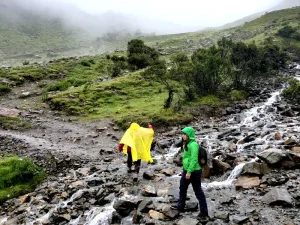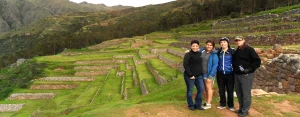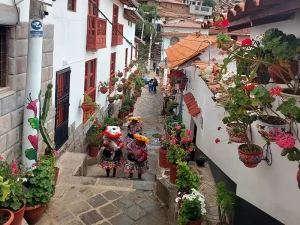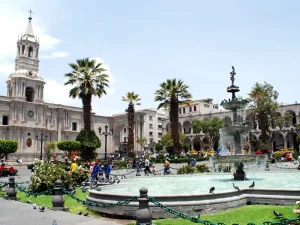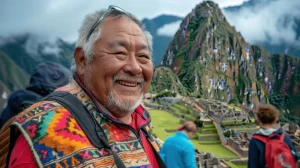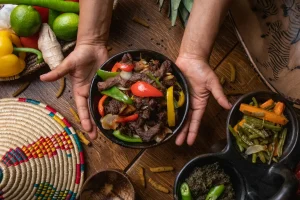The first time I truly understood the magic of my homeland, I was eight years old, hiking with my father along an old Inca trail near Cusco, not another soul in sight. The air was thin and crisp, smelling of eucalyptus and damp earth. As we rounded a bend, the morning mist—the q’espera as we call it in Quechua—parted like a curtain, revealing the lost city of Machu Picchu cradled between two majestic green peaks. It wasn’t just the sight that took my breath away; it was the silence, broken only by the call of an Andean condor soaring overhead. My father placed a hand on my shoulder and said, “Remember this feeling, mijo. This is not just history. It is alive. This is Peru.”
That feeling—awe, wonder, and a deep spiritual connection—is what I want for every traveler who sets foot in this land. Peru is so much more than a checklist of famous sites. It’s a tapestry woven from ancient threads, colonial history, vibrant living cultures, and staggering natural beauty. As your native guide, I invite you to look beyond the postcards and join me on a journey to the heart and soul of Peru. Here are the top 9 places that will forever change you.
A Journey Through the Heart of Peru
Imagine standing at dawn on a mist-covered mountain, the first rays of sunlight touching ancient stones built by the Incas. The silence is broken only by the sound of a distant condor gliding across the Andes. This is Peru—a land where history and nature dance together in harmony.
As a Peruvian guide, born and raised among these mountains and valleys, I often tell my travelers: Peru is not a destination you simply visit—it’s a country you live, breathe, and feel in your soul. From the mysteries of Machu Picchu to the vibrant Amazon rainforest, every corner tells a story.
In this guide, I will take you through the top 9 places to visit in Peru, weaving together history, legends, practical tips, and personal insights so you can experience Peru like a local, not just a tourist.
Why Peru Belongs on Every Traveler’s Bucket List
Peru is not just famous for Machu Picchu—it’s a world within a country. Here’s why it should be on your list:
- Cultural Richness: Over 5,000 years of history, from pre-Inca civilizations to Spanish colonial heritage.
- Natural Diversity: Coast, highlands, and jungle—each offering unique experiences.
- Living Traditions: Festivals, music, dances, and food still deeply rooted in ancestral practices.
- Adventure & Spirituality: Whether hiking, rafting, or connecting with nature, Peru awakens something inside you.
Machu Picchu – The Lost City of the Incas
Why It Matters
Perched at 2,430 meters (7,970 ft) above the Sacred Valley, this 15th-century Inca citadel was never found by the Spanish conquistadors. Its discovery in 1911 by Hiram Bingham meant the world could finally witness Inca architectural genius in its purest form—a city of perfectly carved stone terraces, temples, and plazas seamlessly integrated into the mountain itself.
A Local’s Perspective & Hidden Gems
While the classic view from the Guardhouse is iconic, the real magic lies in going deeper.
- Hike Huayna Picchu: The steep mountain towering behind the ruins. The hour-long climb is challenging but rewards you with a breathtaking bird’s-eye view of the entire citadel. Permits are limited and must be booked months in advance.
- Enter through the Sun Gate (Inti Punku): Instead of taking the bus up, hike the final part of the Inca Trail. Arriving at Machu Picchu through the same entrance the Incas used, as the sun rises, is an experience brimming with emotion and history.
- The Temple of the Moon: A lesser-visited, mystical cave temple located on the back side of Huayna Picchu, believed to be a place of ceremonial worship.
How to Get There: The journey is part of the experience. Most travelers take a train from Ollantaytambo or Cusco to the town of Aguas Calientes. From there, buses wind their way up the mountain. For the adventurous, the 4-day Inca Trail trek is the ultimate pilgrimage.
Best Time to Visit: The dry season, from April to October, offers clear skies and the best conditions for hiking. May and September are sweet spots with good weather and slightly fewer crowds.
Why Visit Machu Picchu?
No list of Peru’s wonders is complete without Machu Picchu. Built in the 15th century and hidden in the cloud forest, it is both a UNESCO World Heritage site and one of the New Seven Wonders of the World.
Walking among its terraces and temples, you’ll feel the same awe that explorers did when Hiram Bingham rediscovered it in 1911.
What to See
- The Sun Gate (Inti Punku): The classic viewpoint if you hike the Inca Trail.
- The Temple of the Sun: An Inca masterpiece aligning with solstices.
- Huayna Picchu Mountain: A challenging climb with breathtaking views.
Travel Tip
Book tickets months in advance—daily entry is limited. Bring layers, sunscreen, and water.
2. Cusco – The Imperial City
Cusco, once the capital of the Inca Empire, is the perfect blend of ancient and colonial. Walking its cobblestone streets feels like stepping into a living museum.
Why It Matters
Cusco is a living museum where Inca foundations support beautiful Spanish colonial churches and convents. The city pulses with energy—a fusion of indigenous Quechua culture, colonial history, and a vibrant, modern tourist scene.
What to See and Do
- Explore the Plaza de Armas: The heart of the city, surrounded by the magnificent Cusco Cathedral and the beautiful church of La Compañía de Jesús.
- Qorikancha (Temple of the Sun): This was the richest temple in the Inca Empire, its walls once plated in gold. The Spanish built the Church of Santo Domingo on top of its flawless stonework—a powerful symbol of cultural clash and fusion.
- Wander San Blas Neighborhood: A charming, hilly area full of narrow cobblestone streets, artisan workshops, and bohemian cafes. It’s the perfect place to get lost and find a unique souvenir.
- Visit Sacsayhuamán: The massive fortress overlooking the city is a stunning example of Inca military architecture. The enormous stones, some weighing over 100 tons, fit together with impossible precision without a single drop of mortar.
Authentic Experience: Don’t just try cuy (guinea pig) at a fancy restaurant. Visit the San Pedro Central Market to see how locals really shop. Sample exotic fruits, try a fresh chicha morada (purple corn drink), and feel the city’s vibrant pulse.
Highlights
- Plaza de Armas: The heart of Cusco, surrounded by churches and cafes.
- Qorikancha: The Inca Temple of the Sun, later transformed into a colonial convent.
- San Pedro Market: A feast for your senses—taste local fruits, cheeses, and fresh juices.
Travel Tip
Spend at least two days acclimatizing in Cusco before heading to higher-altitude sites like Rainbow Mountain or Lake Titicaca.
3. Sacred Valley of the Incas
Just outside Cusco lies the Sacred Valley, a lush corridor of rivers, mountains, and ancient ruins.
Why It Matters
This serene valley is dotted with some of Peru’s most impressive Inca ruins, traditional weaving villages, and stunning landscapes. It’s the perfect place to acclimatize and immerse yourself in Andean culture.
Top Sites in the Sacred Valley:
- Pisac: Famous for its sprawling Inca ruins with incredible terracing and a famous Sunday market (though its artisan market is vibrant any day of the week).
- Ollantaytambo: One of the best-preserved Inca towns, where residents still live in original Inca-era canyons. Its massive fortress was the site of a rare Inca victory over the Spanish.
- Moray: A bizarre and fascinating set of concentric circular terraces believed to have been an Inca agricultural laboratory for experimenting with crops at different altitudes.
- Maras Salt Mines: Thousands of pre-Inca salt pans cascading down a mountainside, still harvested by local families using methods unchanged for centuries.
Travel Tip: Spend at least two nights here. Stay in a village like Urubamba or Ollantaytambo to truly appreciate the valley’s peaceful rhythm.
Must-See Spots
- Pisac: Known for its colorful market and hillside ruins.
- Ollantaytambo: An Inca town still alive, with massive terraces and a fortress.
- Moray & Maras: Circular agricultural terraces and salt mines that look like a patchwork quilt.
Local Experience
Try chicha morada (purple corn drink) or visit a weaving community to learn about Andean textiles.
4. Lake Titicaca – The Highest Navigable Lake in the World
Sitting at 3,812 meters, Lake Titicaca is both breathtaking and spiritual. The lake is considered the birthplace of the Inca civilization.
Why It Matters
The lake’s immense blue expanse, set against the backdrop of the Cordillera Real mountains, is surreal. But its true magic lies in the cultures of the Uros and Taquile people who call it home.
Authentic Experiences:
- Uros Floating Islands: Visit the incredible man-made islands constructed entirely from totora reeds. While touristy, it’s a genuine chance to learn about a unique way of life that has persisted for centuries.
- Taquile Island: A UNESCO World Heritage site for its Intangible Cultural Heritage. The men here are master knitters, and the community operates on a collective, cooperative system that feels untouched by time. The hike across the island offers stunning views and a profound sense of peace.
- Homestay on Amantani Island: For the most authentic experience, arrange an overnight stay with a local family. They’ll dress you in traditional clothes, share a simple meal, and you might even be invited to a community dance in the evening under a blanket of the most intense stars you’ve ever seen.
How to Get There: The gateway city is Puno, reached by a scenic train from Cusco (a full-day journey) or a shorter bus or car ride.
What Makes It Special
- Uros Floating Islands: Man-made islands built from reeds, where locals still live traditionally.
- Taquile Island: Famous for its textiles, declared a UNESCO cultural heritage.
Travel Tip
Nights are cold—pack warm clothes. Don’t miss a sunrise boat ride for magical views.
5. Arequipa & the Colca Canyon
Known as the “White City,” Arequipa is surrounded by volcanoes and built from sillar, a volcanic white stone.
Why It Matters
Arequipa boasts a distinct culture and cuisine, a stunning colonial center (a UNESCO site), and a fierce pride among its residents, known as arequipeños.
What to See and Do:
- Santa Catalina Monastery: A mesmerizing, walled city within a city. This 16th-century monastery is a labyrinth of cobbled streets, cloisters, and plazas painted in vibrant shades of blue, orange, and red. It’s a photographer’s dream.
- Plaza de Armas: Arguably Peru’s most beautiful main square, framed by the gorgeous basilica and elegant arcades.
- Sample the Food: Arequipa is Peru’s culinary capital outside of Lima. You must try rocoto relleno (spicy stuffed pepper), adobo (a pork stew), and queso helado (a frozen cinnamon and coconut dessert that isn’t cheese!).
- Colca Canyon: A two-hour drive from the city lies one of the world’s deepest canyers, twice as deep as the Grand Canyon. The main draw is watching the majestic Andean condors soar on thermal updrafts from the Cruz del Cóndor viewpoint. Trekking into the canyon is a challenging but unforgettable adventure.
Why Visit?
- Santa Catalina Monastery: A colorful colonial gem.
- Colca Canyon: Twice as deep as the Grand Canyon and home to the majestic condor.
- Plaza de Armas: One of the most beautiful squares in South America.
Local Flavor
Try rocoto relleno (stuffed spicy pepper) and queso helado (a unique Arequipeño ice cream).
6. Nazca Lines – Ancient Geoglyphs in the Desert
These mysterious lines, etched into the desert over 1,500 years ago, depict animals, plants, and geometric figures visible only from the sky.
Why It Matters
Created by the Nazca culture between 500 BCE and 500 CE, their purpose remains one of the world’s great archaeological mysteries. Were they astronomical calendars, religious symbols, or pathways for water deities? Seeing them sparks wonder and curiosity like few other places on earth.
How to See Them: You take a 30-minute flight in a small Cessna aircraft from the town of Nazca. It’s a bumpy but thrilling ride as the pilot banks left and right to give passengers on both sides a view.
Tip: If you’re prone to motion sickness, take medication beforehand!
Experience
Take a small plane flight for the best view—or climb the observation towers for a ground-level glimpse.
Legend
Local myths say the lines were messages to the gods, while scientists believe they were astronomical calendars.
7. Lima – The City of Kings
Often overlooked, Lima is Peru’s vibrant capital and a gastronomic paradise.
Things to Do
- Historic Center: Baroque churches and colonial balconies.
- Miraflores & Barranco: Trendy districts with ocean views and street art.
- Peruvian Cuisine: Lima is the food capital of South America—don’t miss ceviche, lomo saltado, and anticuchos.
Travel Tip
Book a food tour—it’s the best way to understand Lima’s soul.
8. The Amazon Rainforest (Iquitos or Puerto Maldonado)
Peru holds one of the largest portions of the Amazon. It’s a world of endless biodiversity.
Why It Matters
This is one of the most biodiverse places on Earth. A journey here is a sensory overload in the best way: the symphony of howler monkeys and macaws, the smell of rain on wet clay, and the sight of towering kapok trees.
Top Gateways:
- Iquitos: The world’s largest city inaccessible by road, accessed only by air or boat. From here, you travel to remote lodges in the Pacaya-Samiria National Reserve. This area is known for its incredible wildlife, including pink river dolphins, sloths, and giant river otters.
- Puerto Maldonado: Easier to access from Cusco (a short flight or long bus ride), leading to the Tambopata National Reserve or Manu National Park (though Manu requires more time). This is a great option for a shorter jungle excursion (3-4 days).
What to Do: Take guided night walks to see insects and frogs, go caiman spotting on a night boat safari, climb a canopy tower to see the forest from above, and visit a local chacra (farm) to learn about jungle sustainability.
Options
- Iquitos: Best for river cruises and cultural immersion.
- Puerto Maldonado: Easier access from Cusco, with eco-lodges and wildlife safaris.
Unique Experience
Spot pink river dolphins, giant otters, and medicinal plants with a local shaman.
9. Rainbow Mountain (Vinicunca)
A relatively new star in Peru’s tourism, Rainbow Mountain amazes travelers with its colorful stripes caused by mineral deposits.
Travel Info
The trek reaches 5,200 meters, so acclimatization is crucial. Start early in the morning for the best light and fewer crowds.
Other tourist attractions in Peru
1. Nazca Lines: The Ancient Mystery
Scratched into the arid plains of the Nazca Desert are hundreds of enormous geoglyphs—figures of monkeys, hummingbirds, spiders, and geometric shapes so large they can only be fully appreciated from the air.
Why It Matters
Created by the Nazca culture between 500 BCE and 500 CE, their purpose remains one of the world’s great archaeological mysteries. Were they astronomical calendars, religious symbols, or pathways for water deities? Seeing them sparks wonder and curiosity like few other places on earth.
How to See Them: You take a 30-minute flight in a small Cessna aircraft from the town of Nazca. It’s a bumpy but thrilling ride as the pilot banks left and right to give passengers on both sides a view.
Tip: If you’re prone to motion sickness, take medication beforehand!
2. Huacachina: A Desert Oasis
Rising from the flat, featureless desert near the city of Ica is a literal oasis. Huacachina is a small, natural lagoon surrounded by palm trees and encircled by enormous sand dunes that stretch for miles.
Why It Matters
It feels like a mirage. This is the place for pure, unadulterated adventure and fun.
What to Do: Take a dune buggy tour—it’s a rollercoaster ride over the dunes. Then, try sandboarding down the steep slopes. As the day ends, climb to the top of a dune to watch one of the most spectacular sunsets of your life, as the sky turns shades of orange and purple over the endless sea of sand.
3. Trujillo & the Northern Kingdoms
While the south gets most of the attention, northern Peru holds its own with incredible pre-Inca archaeological sites and world-class surfing beaches.
Why It Matters
This region was home to powerful ancient civilizations like the Moche and Chimú, whose massive adobe cities rival the Incas in scale and sophistication.
Top Attractions:
- Chan Chan: Near Trujillo, this was the largest adobe city in the pre-Columbian Americas and the capital of the Chimú Kingdom. Walking through its vast, intricate walls adorned with fish and bird motifs is awe-inspiring.
- Huaca de la Luna & Huaca del Sol: Two giant Moche temples near Trujillo. Huaca de la Luna is famous for its brilliantly preserved polychrome friezes depicting the decapitator god, Ai Apaec.
- Máncora: Further north, this beach town is Peru’s premier surf destination, with a lively party scene, great seafood, and warm water year-round.
Authentic Experiences: Beyond the Tourist Path
While these are Peru’s top places, don’t miss out on:
- Local festivals like Inti Raymi in Cusco or Virgen de la Candelaria in Puno.
- Trying street food—anticuchos and picarones are favorites.
- Visiting markets to connect with locals.
Best Time to Visit Peru
- Dry Season (May–September): Ideal for trekking and visiting highland attractions.
- Wet Season (November–March): Fewer crowds, greener landscapes, but heavy rains in the Andes.
How to Get Around Peru
- By Plane: Best for long distances (Lima–Cusco, Lima–Iquitos).
- By Bus: Affordable and scenic, though long rides.
- By Train: Iconic journeys like Cusco–Machu Picchu or Cusco–Puno.
Travel Tips for Visiting Peru
- Altitude: Take it slow, drink coca tea, and stay hydrated.
- Safety: Peru is safe for travelers, but use common sense in big cities.
- Packing: Layers for the Andes, light clothes for the coast, and insect repellent for the Amazon.
Comparison with Other South American Destinations
While Argentina boasts Patagonia and Brazil has Rio, Peru stands out for its unique blend of history, culture, and nature. Few countries allow you to hike ancient ruins in the morning, surf in the afternoon, and explore the jungle the next day.
FAQs About Traveling in Peru
Is Peru safe for tourists?
Yes, the main tourist areas like Cusco, the Sacred Valley, and Arequipa are generally very safe. Like anywhere, you must practice common sense: be aware of your surroundings, don’t flash expensive jewelry, use registered taxis, and be cautious in crowded areas to avoid pickpockets.
What is the best time of year to visit Peru?
The overall best time for visiting most regions, including Cusco and Machu Picchu, is the dry season (April to October). For the Amazon, it’s better to go in the drier months (May to October) for hiking, though the wet season offers better river access. The coast (Lima, Paracas, Huacachina) is best from December to March for sun.
Do I need to worry about altitude sickness?
Altitude sickness (soroche) is a real concern in Cusco (3,400m) and Puno (3,800m). The key is to acclimatize slowly. Spend your first 2-3 days taking it easy, drink plenty of water and coca tea, avoid heavy meals and alcohol. Medications like Diamox can help; consult your doctor.
How many days do I need for a trip to Peru?
To see the highlights (Lima, Cusco, Sacred Valley, Machu Picchu) at a comfortable pace, you need a minimum of 10 days. To add another region like Lake Titicaca or the Amazon, plan for a solid 2 to 3 weeks.
What should I pack for Peru?
Pack for all seasons, no matter when you go! The key is layers.
- Andes: Fleece jacket, waterproof shell, thermal layers, hiking boots, hat, gloves, sunscreen, and a good daypack.
- Amazon: Lightweight, long-sleeved shirts and pants (for mosquitoes), rain gear, sturdy boots, insect repellent with DEET, and a headlamp.
- Coast: Swimwear, sunscreen, hat, and light clothing for summer (Dec-Mar); a jacket for the garúa (coastal fog) in winter.
Comparison: Peru vs. Other South American Destinations
| Feature | Peru | Chile | Argentina | Ecuador |
| Key Attraction | Ancient Archaeology (Inca/Pre-Inca) | Natural Diversity (Desert, Lakes, Fjords) | European Culture & Food | Compact Diversity (Galapagos, Andes) |
| Landscape | Extremely diverse: Coast, Andes, Amazon | Long and narrow: Dramatic mountains & coast | Pampas, Patagonia, Wine Country | Andes, Amazon, Coast (smaller scale) |
| Signature Food | Ceviche, Lomo Saltado, Cuisine is a key draw | Seafood, Wine, Pastel de Choclo | Steak, Malbec Wine, Dulce de Leche | Ceviche, Encebollado, Cuy |
| Best For | History buffs, adventurers, foodies | Nature lovers, hikers, wine enthusiasts | Food & wine, tango, cosmopolitan travel | First-time S.A. travelers, wildlife, short trips |
Conclusion: Your Peruvian Adventure Awaits
Peru is a country that gets under your skin. It’s the taste of a freshly caught ceviche with a hint of ají, the sound of a Quechua greeting in a highland market, the feeling of humility staring up at the same stars that guided the Incas. It’s a land of profound contrasts and endless discovery.
This list is just the beginning. My greatest advice is to not just see Peru, but to experience it. Talk to the people, try the strange-looking fruit, learn a few words of Spanish or Quechua, and let the rhythm of the land guide you. Ready to answer the call of the Andes? As a local, I always encourage travelers to book with a reputable, Peruvian-based tour operator. They handle the complex logistics (like Inca Trail permits and train tickets), provide deep cultural context through expert guides, and ensure your journey is not just a vacation, but a transformative experience. Come, let us share our home with you.

